National Tourism Policy of Philippines: Evaluation Report
VerifiedAdded on 2022/08/08
|31
|6905
|37
Report
AI Summary
This report delves into the tourism sector of the Philippines, assessing the impact of tourism on the nation's economy, considering its benefits like revenue generation, foreign currency reserves, employment opportunities, and environmental sustainability. The research employs PESTEL and Porter's Five Forces analyses to scrutinize external and competitive factors influencing the industry. The report evaluates the existing national tourism policy, its strengths, weaknesses, and value for tourism business development. It also provides recommendations for strategic improvements, including identifying areas for development, suggesting infrastructure enhancements, and specifying key programs and resource requirements to achieve the country's tourism vision. The analysis is based on the National Tourism Development Plan 2016-2022 and other relevant data sources.
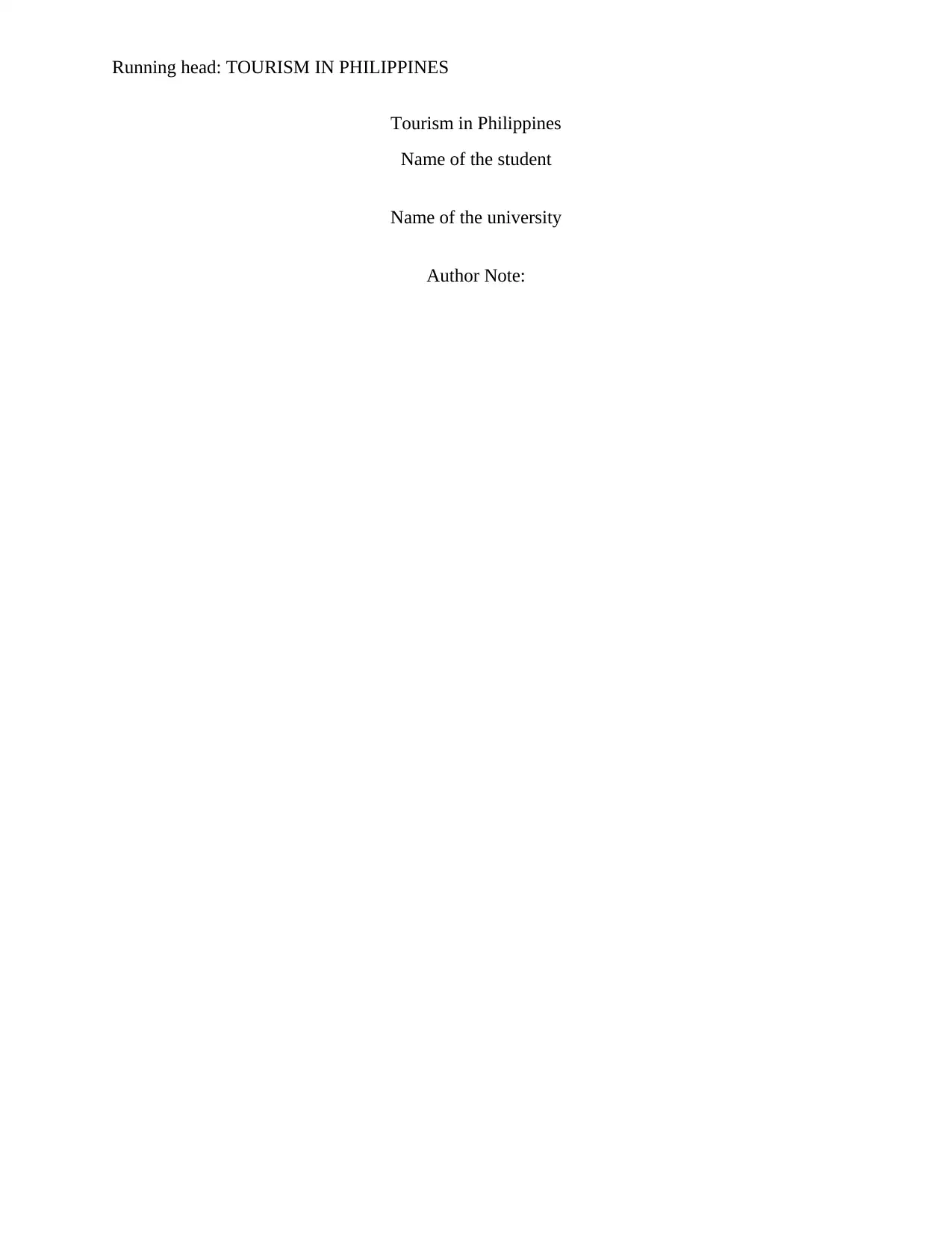
Running head: TOURISM IN PHILIPPINES
Tourism in Philippines
Name of the student
Name of the university
Author Note:
Tourism in Philippines
Name of the student
Name of the university
Author Note:
Paraphrase This Document
Need a fresh take? Get an instant paraphrase of this document with our AI Paraphraser
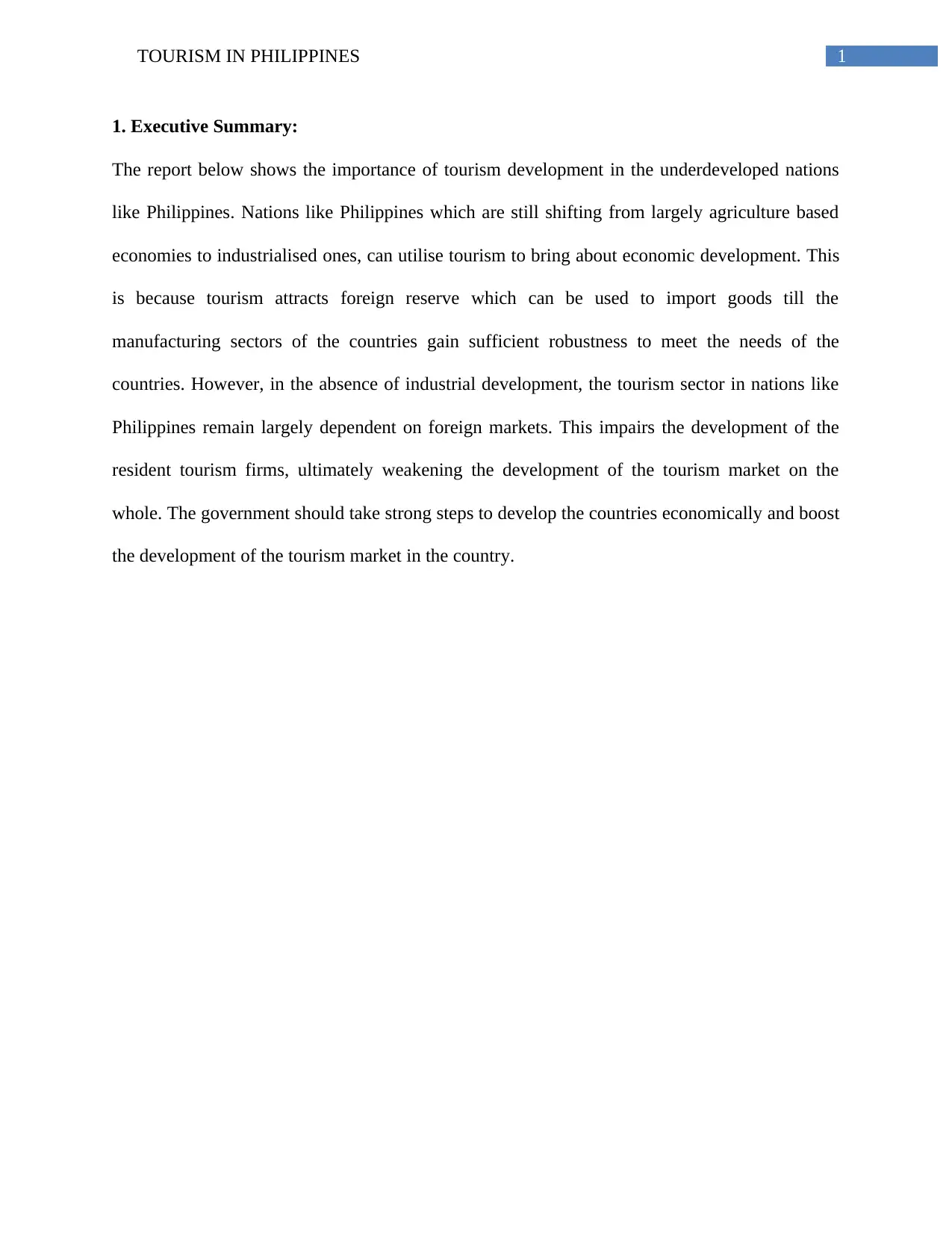
1TOURISM IN PHILIPPINES
1. Executive Summary:
The report below shows the importance of tourism development in the underdeveloped nations
like Philippines. Nations like Philippines which are still shifting from largely agriculture based
economies to industrialised ones, can utilise tourism to bring about economic development. This
is because tourism attracts foreign reserve which can be used to import goods till the
manufacturing sectors of the countries gain sufficient robustness to meet the needs of the
countries. However, in the absence of industrial development, the tourism sector in nations like
Philippines remain largely dependent on foreign markets. This impairs the development of the
resident tourism firms, ultimately weakening the development of the tourism market on the
whole. The government should take strong steps to develop the countries economically and boost
the development of the tourism market in the country.
1. Executive Summary:
The report below shows the importance of tourism development in the underdeveloped nations
like Philippines. Nations like Philippines which are still shifting from largely agriculture based
economies to industrialised ones, can utilise tourism to bring about economic development. This
is because tourism attracts foreign reserve which can be used to import goods till the
manufacturing sectors of the countries gain sufficient robustness to meet the needs of the
countries. However, in the absence of industrial development, the tourism sector in nations like
Philippines remain largely dependent on foreign markets. This impairs the development of the
resident tourism firms, ultimately weakening the development of the tourism market on the
whole. The government should take strong steps to develop the countries economically and boost
the development of the tourism market in the country.
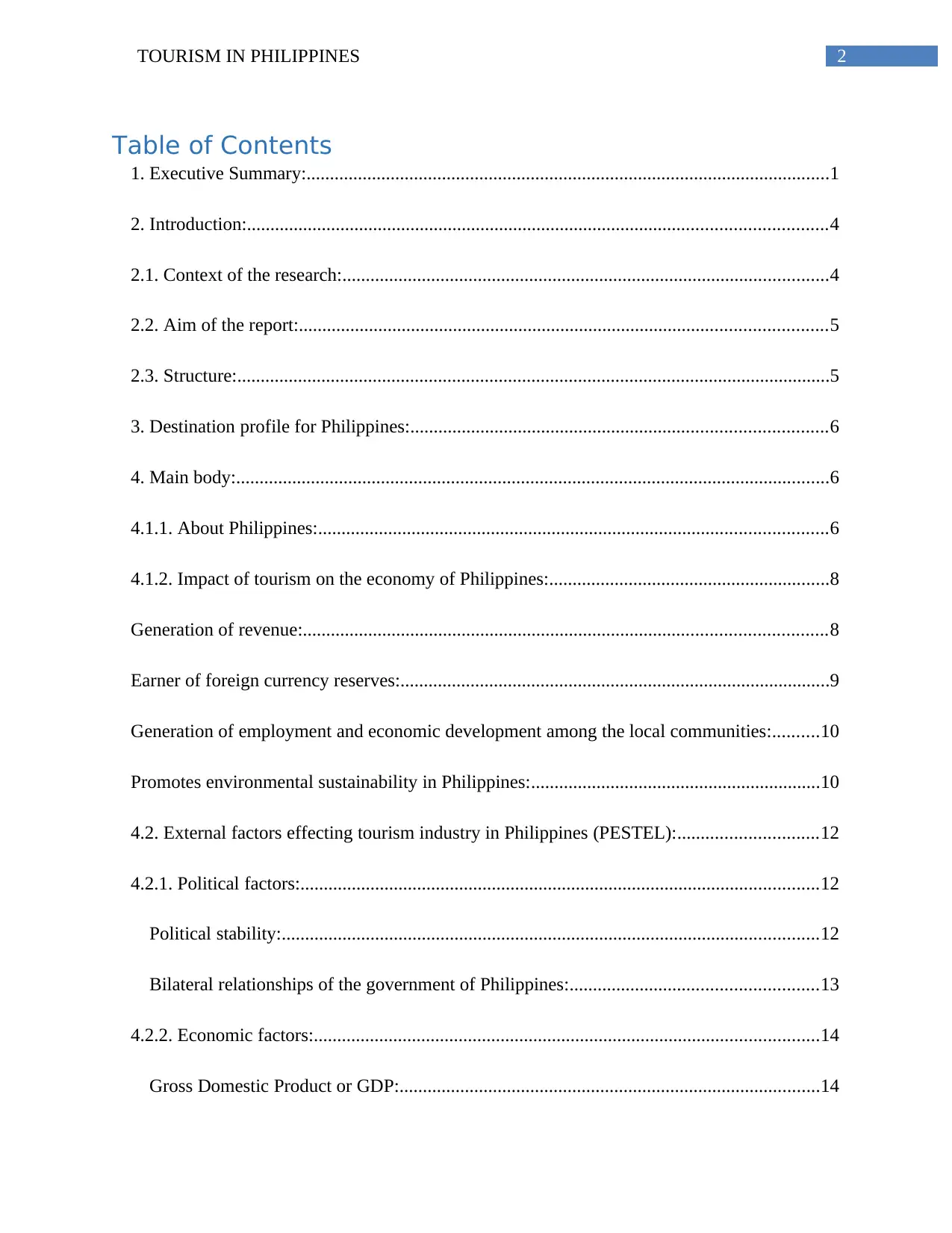
2TOURISM IN PHILIPPINES
Table of Contents
1. Executive Summary:................................................................................................................1
2. Introduction:............................................................................................................................4
2.1. Context of the research:........................................................................................................4
2.2. Aim of the report:.................................................................................................................5
2.3. Structure:...............................................................................................................................5
3. Destination profile for Philippines:.........................................................................................6
4. Main body:...............................................................................................................................6
4.1.1. About Philippines:.............................................................................................................6
4.1.2. Impact of tourism on the economy of Philippines:............................................................8
Generation of revenue:................................................................................................................8
Earner of foreign currency reserves:............................................................................................9
Generation of employment and economic development among the local communities:..........10
Promotes environmental sustainability in Philippines:..............................................................10
4.2. External factors effecting tourism industry in Philippines (PESTEL):..............................12
4.2.1. Political factors:...............................................................................................................12
Political stability:...................................................................................................................12
Bilateral relationships of the government of Philippines:.....................................................13
4.2.2. Economic factors:............................................................................................................14
Gross Domestic Product or GDP:..........................................................................................14
Table of Contents
1. Executive Summary:................................................................................................................1
2. Introduction:............................................................................................................................4
2.1. Context of the research:........................................................................................................4
2.2. Aim of the report:.................................................................................................................5
2.3. Structure:...............................................................................................................................5
3. Destination profile for Philippines:.........................................................................................6
4. Main body:...............................................................................................................................6
4.1.1. About Philippines:.............................................................................................................6
4.1.2. Impact of tourism on the economy of Philippines:............................................................8
Generation of revenue:................................................................................................................8
Earner of foreign currency reserves:............................................................................................9
Generation of employment and economic development among the local communities:..........10
Promotes environmental sustainability in Philippines:..............................................................10
4.2. External factors effecting tourism industry in Philippines (PESTEL):..............................12
4.2.1. Political factors:...............................................................................................................12
Political stability:...................................................................................................................12
Bilateral relationships of the government of Philippines:.....................................................13
4.2.2. Economic factors:............................................................................................................14
Gross Domestic Product or GDP:..........................................................................................14
⊘ This is a preview!⊘
Do you want full access?
Subscribe today to unlock all pages.

Trusted by 1+ million students worldwide
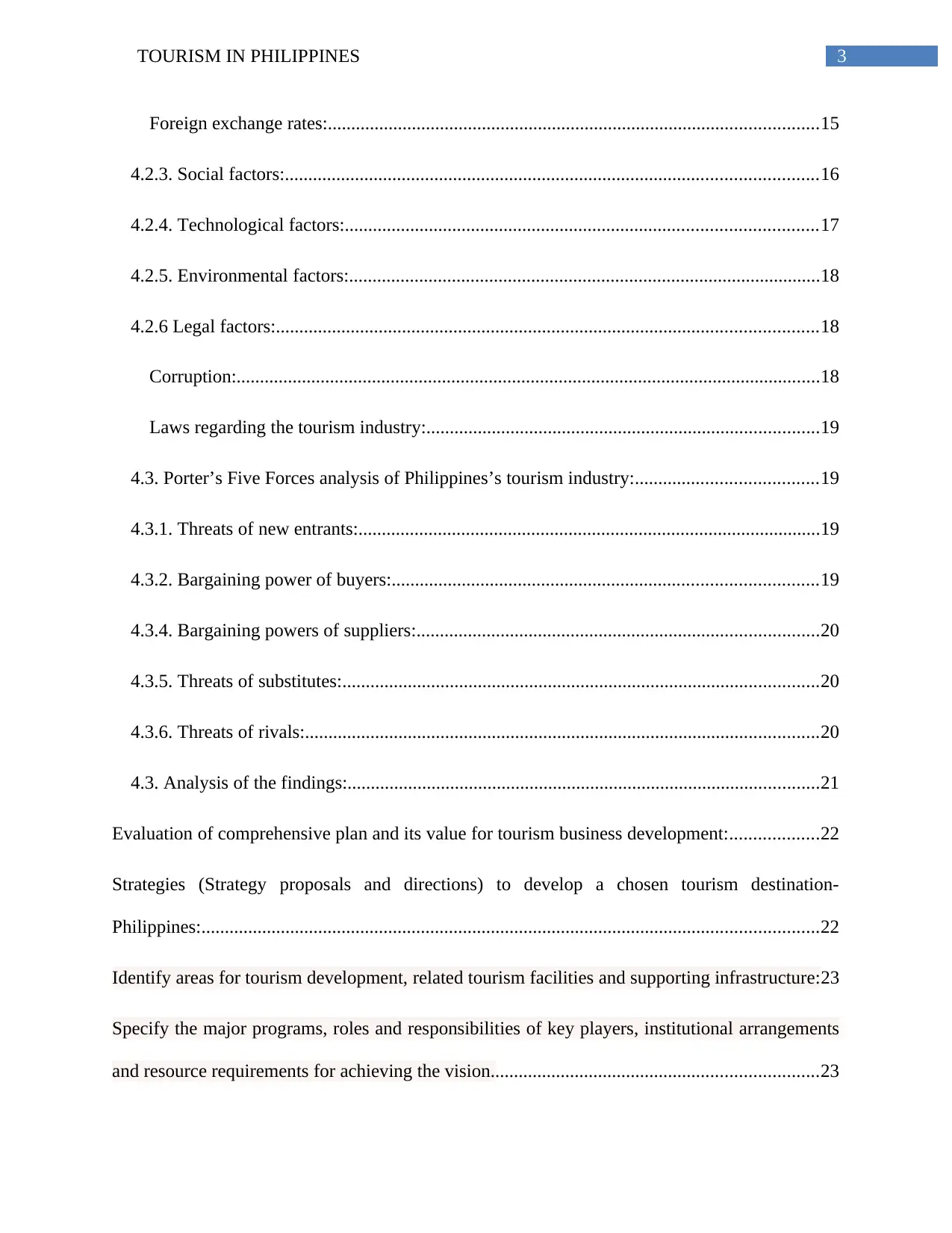
3TOURISM IN PHILIPPINES
Foreign exchange rates:.........................................................................................................15
4.2.3. Social factors:..................................................................................................................16
4.2.4. Technological factors:.....................................................................................................17
4.2.5. Environmental factors:.....................................................................................................18
4.2.6 Legal factors:....................................................................................................................18
Corruption:.............................................................................................................................18
Laws regarding the tourism industry:....................................................................................19
4.3. Porter’s Five Forces analysis of Philippines’s tourism industry:.......................................19
4.3.1. Threats of new entrants:...................................................................................................19
4.3.2. Bargaining power of buyers:...........................................................................................19
4.3.4. Bargaining powers of suppliers:......................................................................................20
4.3.5. Threats of substitutes:......................................................................................................20
4.3.6. Threats of rivals:..............................................................................................................20
4.3. Analysis of the findings:.....................................................................................................21
Evaluation of comprehensive plan and its value for tourism business development:...................22
Strategies (Strategy proposals and directions) to develop a chosen tourism destination-
Philippines:....................................................................................................................................22
Identify areas for tourism development, related tourism facilities and supporting infrastructure:23
Specify the major programs, roles and responsibilities of key players, institutional arrangements
and resource requirements for achieving the vision......................................................................23
Foreign exchange rates:.........................................................................................................15
4.2.3. Social factors:..................................................................................................................16
4.2.4. Technological factors:.....................................................................................................17
4.2.5. Environmental factors:.....................................................................................................18
4.2.6 Legal factors:....................................................................................................................18
Corruption:.............................................................................................................................18
Laws regarding the tourism industry:....................................................................................19
4.3. Porter’s Five Forces analysis of Philippines’s tourism industry:.......................................19
4.3.1. Threats of new entrants:...................................................................................................19
4.3.2. Bargaining power of buyers:...........................................................................................19
4.3.4. Bargaining powers of suppliers:......................................................................................20
4.3.5. Threats of substitutes:......................................................................................................20
4.3.6. Threats of rivals:..............................................................................................................20
4.3. Analysis of the findings:.....................................................................................................21
Evaluation of comprehensive plan and its value for tourism business development:...................22
Strategies (Strategy proposals and directions) to develop a chosen tourism destination-
Philippines:....................................................................................................................................22
Identify areas for tourism development, related tourism facilities and supporting infrastructure:23
Specify the major programs, roles and responsibilities of key players, institutional arrangements
and resource requirements for achieving the vision......................................................................23
Paraphrase This Document
Need a fresh take? Get an instant paraphrase of this document with our AI Paraphraser
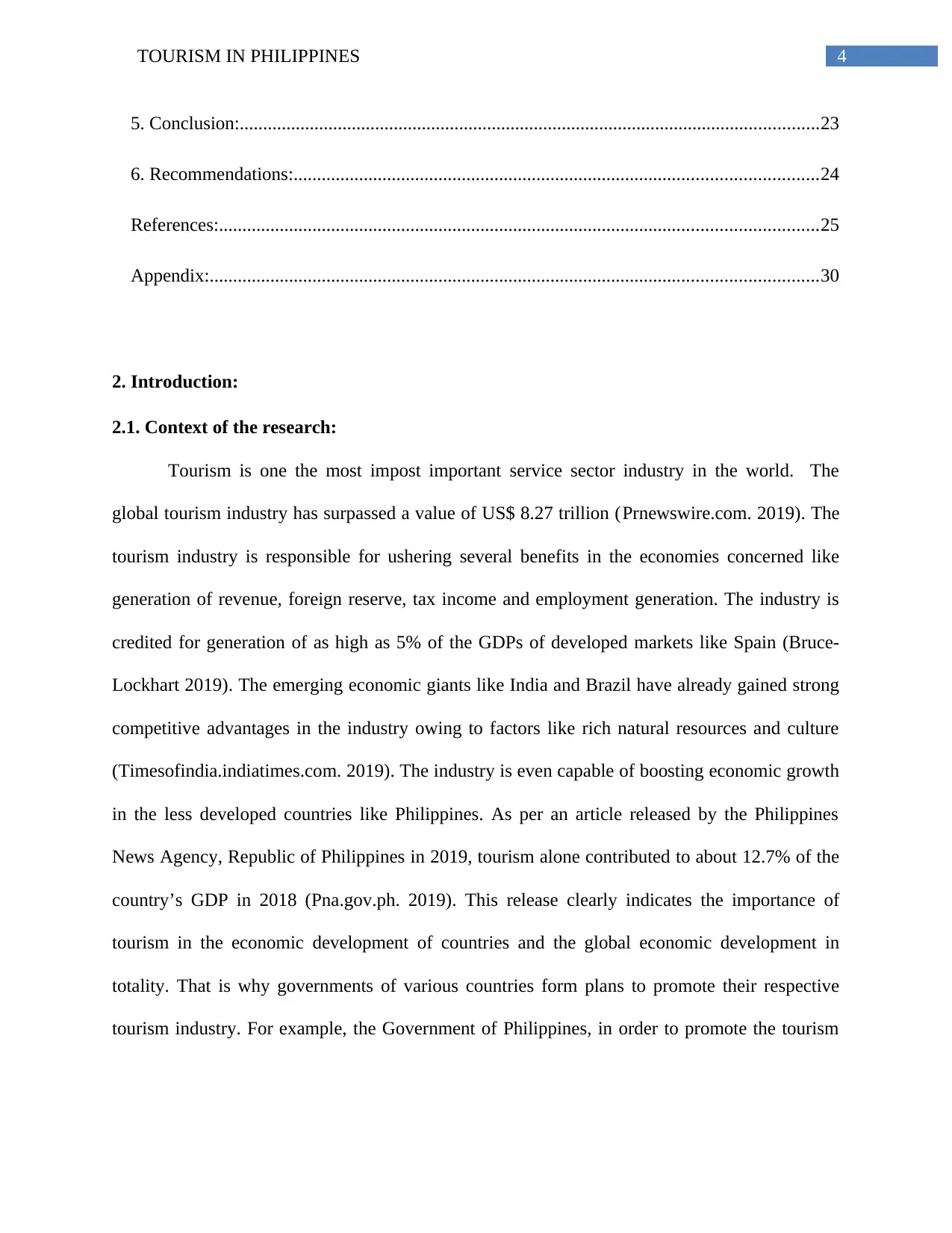
4TOURISM IN PHILIPPINES
5. Conclusion:............................................................................................................................23
6. Recommendations:................................................................................................................24
References:................................................................................................................................25
Appendix:..................................................................................................................................30
2. Introduction:
2.1. Context of the research:
Tourism is one the most impost important service sector industry in the world. The
global tourism industry has surpassed a value of US$ 8.27 trillion (Prnewswire.com. 2019). The
tourism industry is responsible for ushering several benefits in the economies concerned like
generation of revenue, foreign reserve, tax income and employment generation. The industry is
credited for generation of as high as 5% of the GDPs of developed markets like Spain (Bruce-
Lockhart 2019). The emerging economic giants like India and Brazil have already gained strong
competitive advantages in the industry owing to factors like rich natural resources and culture
(Timesofindia.indiatimes.com. 2019). The industry is even capable of boosting economic growth
in the less developed countries like Philippines. As per an article released by the Philippines
News Agency, Republic of Philippines in 2019, tourism alone contributed to about 12.7% of the
country’s GDP in 2018 (Pna.gov.ph. 2019). This release clearly indicates the importance of
tourism in the economic development of countries and the global economic development in
totality. That is why governments of various countries form plans to promote their respective
tourism industry. For example, the Government of Philippines, in order to promote the tourism
5. Conclusion:............................................................................................................................23
6. Recommendations:................................................................................................................24
References:................................................................................................................................25
Appendix:..................................................................................................................................30
2. Introduction:
2.1. Context of the research:
Tourism is one the most impost important service sector industry in the world. The
global tourism industry has surpassed a value of US$ 8.27 trillion (Prnewswire.com. 2019). The
tourism industry is responsible for ushering several benefits in the economies concerned like
generation of revenue, foreign reserve, tax income and employment generation. The industry is
credited for generation of as high as 5% of the GDPs of developed markets like Spain (Bruce-
Lockhart 2019). The emerging economic giants like India and Brazil have already gained strong
competitive advantages in the industry owing to factors like rich natural resources and culture
(Timesofindia.indiatimes.com. 2019). The industry is even capable of boosting economic growth
in the less developed countries like Philippines. As per an article released by the Philippines
News Agency, Republic of Philippines in 2019, tourism alone contributed to about 12.7% of the
country’s GDP in 2018 (Pna.gov.ph. 2019). This release clearly indicates the importance of
tourism in the economic development of countries and the global economic development in
totality. That is why governments of various countries form plans to promote their respective
tourism industry. For example, the Government of Philippines, in order to promote the tourism
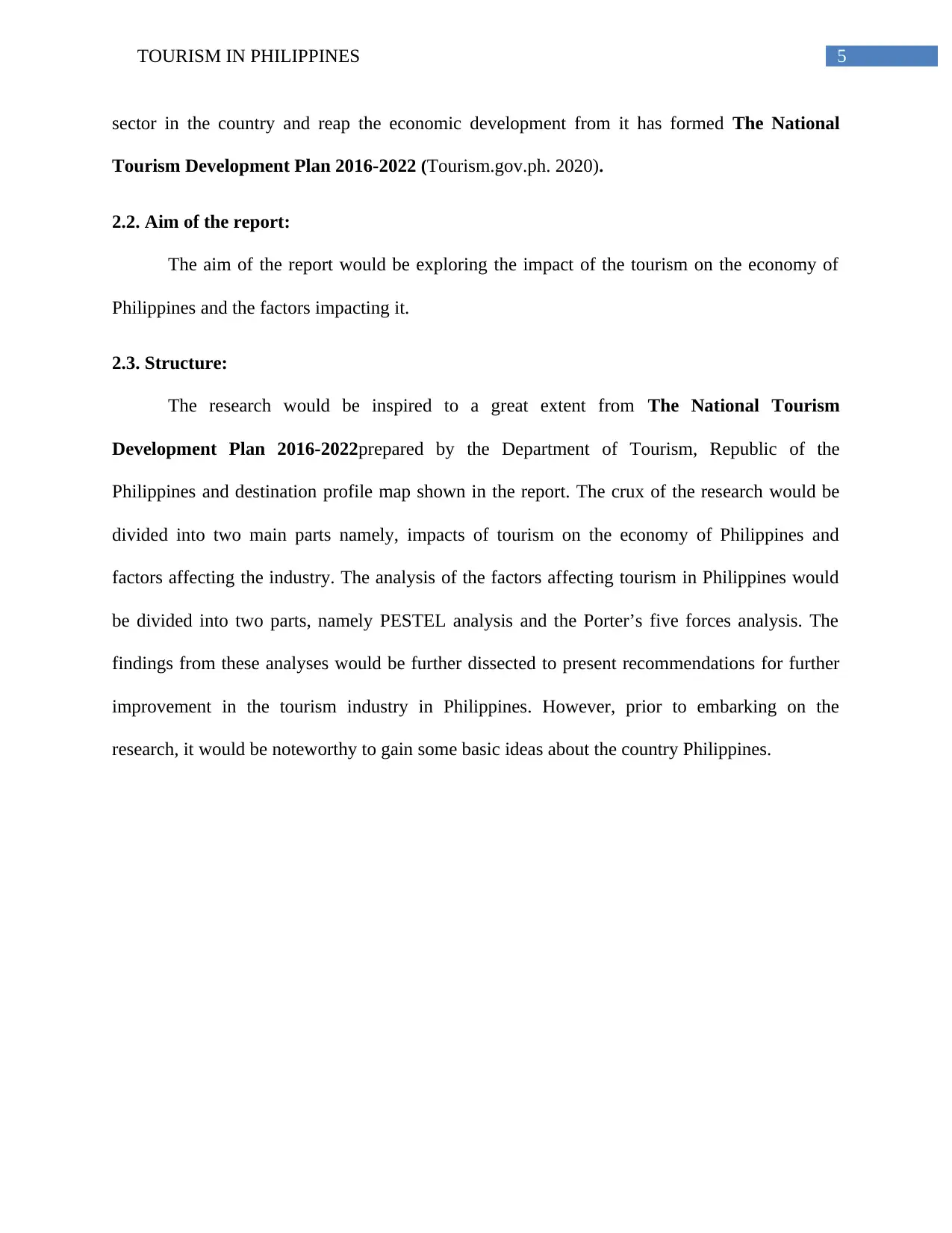
5TOURISM IN PHILIPPINES
sector in the country and reap the economic development from it has formed The National
Tourism Development Plan 2016-2022 (Tourism.gov.ph. 2020).
2.2. Aim of the report:
The aim of the report would be exploring the impact of the tourism on the economy of
Philippines and the factors impacting it.
2.3. Structure:
The research would be inspired to a great extent from The National Tourism
Development Plan 2016-2022prepared by the Department of Tourism, Republic of the
Philippines and destination profile map shown in the report. The crux of the research would be
divided into two main parts namely, impacts of tourism on the economy of Philippines and
factors affecting the industry. The analysis of the factors affecting tourism in Philippines would
be divided into two parts, namely PESTEL analysis and the Porter’s five forces analysis. The
findings from these analyses would be further dissected to present recommendations for further
improvement in the tourism industry in Philippines. However, prior to embarking on the
research, it would be noteworthy to gain some basic ideas about the country Philippines.
sector in the country and reap the economic development from it has formed The National
Tourism Development Plan 2016-2022 (Tourism.gov.ph. 2020).
2.2. Aim of the report:
The aim of the report would be exploring the impact of the tourism on the economy of
Philippines and the factors impacting it.
2.3. Structure:
The research would be inspired to a great extent from The National Tourism
Development Plan 2016-2022prepared by the Department of Tourism, Republic of the
Philippines and destination profile map shown in the report. The crux of the research would be
divided into two main parts namely, impacts of tourism on the economy of Philippines and
factors affecting the industry. The analysis of the factors affecting tourism in Philippines would
be divided into two parts, namely PESTEL analysis and the Porter’s five forces analysis. The
findings from these analyses would be further dissected to present recommendations for further
improvement in the tourism industry in Philippines. However, prior to embarking on the
research, it would be noteworthy to gain some basic ideas about the country Philippines.
⊘ This is a preview!⊘
Do you want full access?
Subscribe today to unlock all pages.

Trusted by 1+ million students worldwide
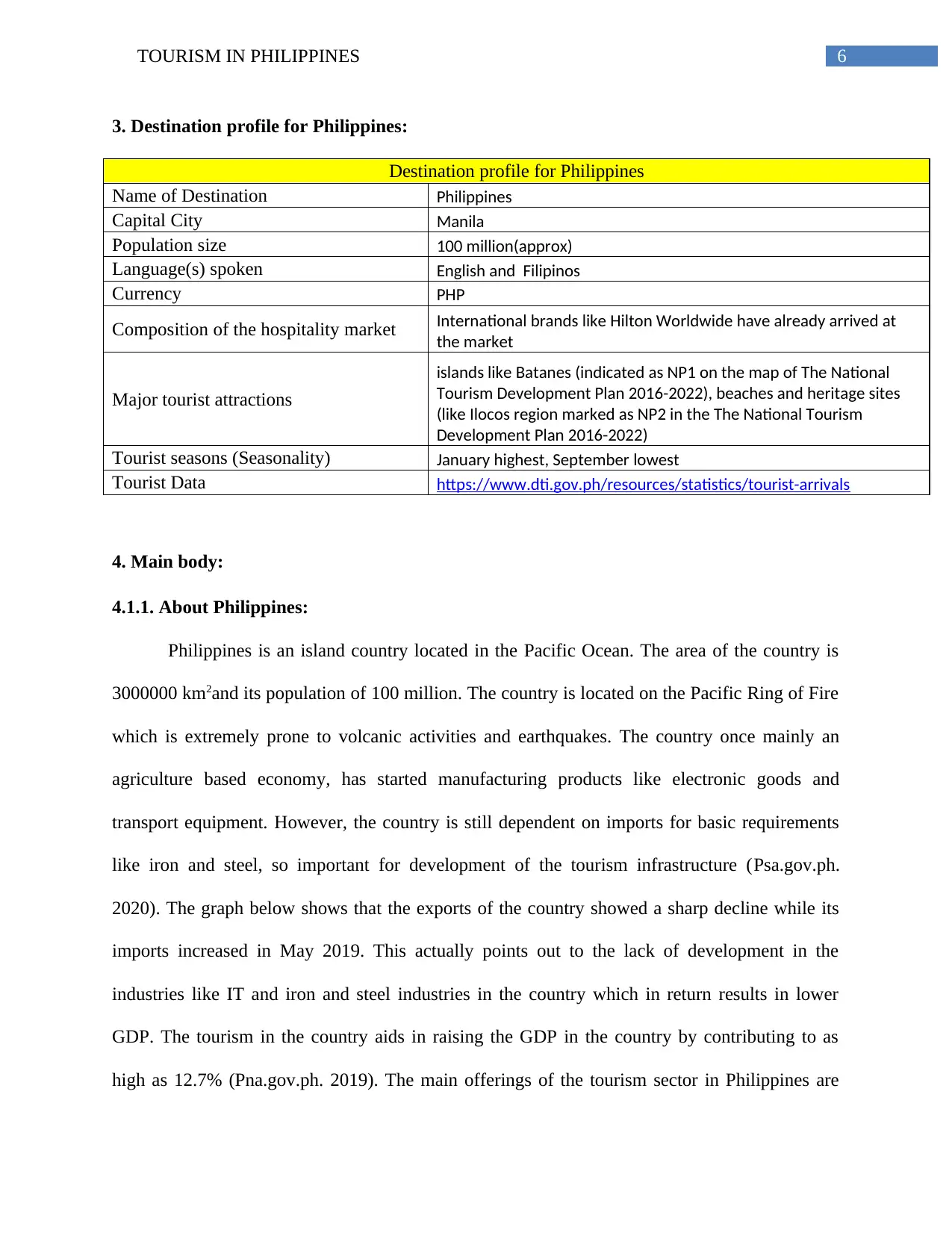
6TOURISM IN PHILIPPINES
3. Destination profile for Philippines:
Destination profile for Philippines
Name of Destination Philippines
Capital City Manila
Population size 100 million(approx)
Language(s) spoken English and Filipinos
Currency PHP
Composition of the hospitality market International brands like Hilton Worldwide have already arrived at
the market
Major tourist attractions
islands like Batanes (indicated as NP1 on the map of The National
Tourism Development Plan 2016-2022), beaches and heritage sites
(like Ilocos region marked as NP2 in the The National Tourism
Development Plan 2016-2022)
Tourist seasons (Seasonality) January highest, September lowest
Tourist Data https://www.dti.gov.ph/resources/statistics/tourist-arrivals
4. Main body:
4.1.1. About Philippines:
Philippines is an island country located in the Pacific Ocean. The area of the country is
3000000 km2and its population of 100 million. The country is located on the Pacific Ring of Fire
which is extremely prone to volcanic activities and earthquakes. The country once mainly an
agriculture based economy, has started manufacturing products like electronic goods and
transport equipment. However, the country is still dependent on imports for basic requirements
like iron and steel, so important for development of the tourism infrastructure (Psa.gov.ph.
2020). The graph below shows that the exports of the country showed a sharp decline while its
imports increased in May 2019. This actually points out to the lack of development in the
industries like IT and iron and steel industries in the country which in return results in lower
GDP. The tourism in the country aids in raising the GDP in the country by contributing to as
high as 12.7% (Pna.gov.ph. 2019). The main offerings of the tourism sector in Philippines are
3. Destination profile for Philippines:
Destination profile for Philippines
Name of Destination Philippines
Capital City Manila
Population size 100 million(approx)
Language(s) spoken English and Filipinos
Currency PHP
Composition of the hospitality market International brands like Hilton Worldwide have already arrived at
the market
Major tourist attractions
islands like Batanes (indicated as NP1 on the map of The National
Tourism Development Plan 2016-2022), beaches and heritage sites
(like Ilocos region marked as NP2 in the The National Tourism
Development Plan 2016-2022)
Tourist seasons (Seasonality) January highest, September lowest
Tourist Data https://www.dti.gov.ph/resources/statistics/tourist-arrivals
4. Main body:
4.1.1. About Philippines:
Philippines is an island country located in the Pacific Ocean. The area of the country is
3000000 km2and its population of 100 million. The country is located on the Pacific Ring of Fire
which is extremely prone to volcanic activities and earthquakes. The country once mainly an
agriculture based economy, has started manufacturing products like electronic goods and
transport equipment. However, the country is still dependent on imports for basic requirements
like iron and steel, so important for development of the tourism infrastructure (Psa.gov.ph.
2020). The graph below shows that the exports of the country showed a sharp decline while its
imports increased in May 2019. This actually points out to the lack of development in the
industries like IT and iron and steel industries in the country which in return results in lower
GDP. The tourism in the country aids in raising the GDP in the country by contributing to as
high as 12.7% (Pna.gov.ph. 2019). The main offerings of the tourism sector in Philippines are
Paraphrase This Document
Need a fresh take? Get an instant paraphrase of this document with our AI Paraphraser
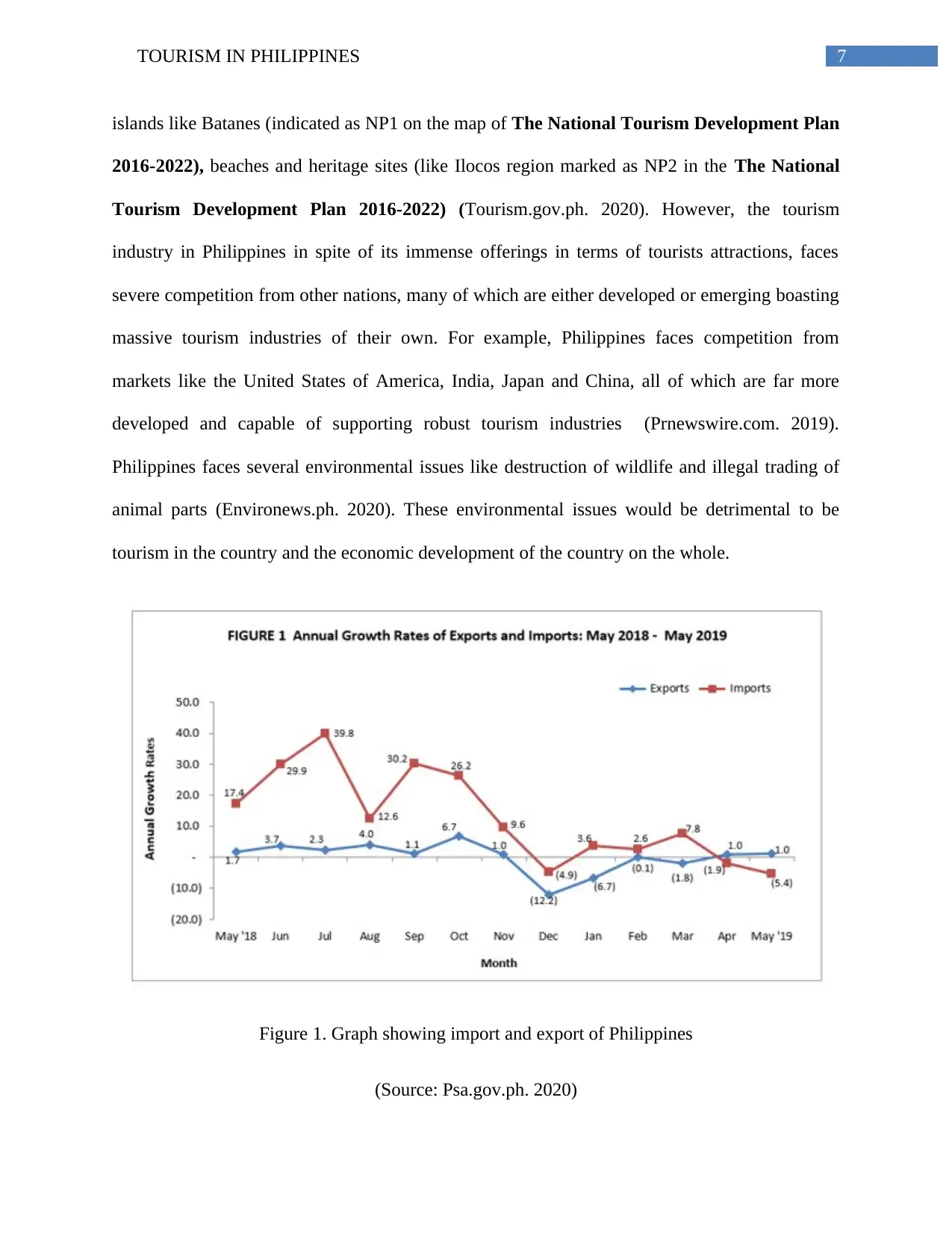
7TOURISM IN PHILIPPINES
islands like Batanes (indicated as NP1 on the map of The National Tourism Development Plan
2016-2022), beaches and heritage sites (like Ilocos region marked as NP2 in the The National
Tourism Development Plan 2016-2022) (Tourism.gov.ph. 2020). However, the tourism
industry in Philippines in spite of its immense offerings in terms of tourists attractions, faces
severe competition from other nations, many of which are either developed or emerging boasting
massive tourism industries of their own. For example, Philippines faces competition from
markets like the United States of America, India, Japan and China, all of which are far more
developed and capable of supporting robust tourism industries (Prnewswire.com. 2019).
Philippines faces several environmental issues like destruction of wildlife and illegal trading of
animal parts (Environews.ph. 2020). These environmental issues would be detrimental to be
tourism in the country and the economic development of the country on the whole.
Figure 1. Graph showing import and export of Philippines
(Source: Psa.gov.ph. 2020)
islands like Batanes (indicated as NP1 on the map of The National Tourism Development Plan
2016-2022), beaches and heritage sites (like Ilocos region marked as NP2 in the The National
Tourism Development Plan 2016-2022) (Tourism.gov.ph. 2020). However, the tourism
industry in Philippines in spite of its immense offerings in terms of tourists attractions, faces
severe competition from other nations, many of which are either developed or emerging boasting
massive tourism industries of their own. For example, Philippines faces competition from
markets like the United States of America, India, Japan and China, all of which are far more
developed and capable of supporting robust tourism industries (Prnewswire.com. 2019).
Philippines faces several environmental issues like destruction of wildlife and illegal trading of
animal parts (Environews.ph. 2020). These environmental issues would be detrimental to be
tourism in the country and the economic development of the country on the whole.
Figure 1. Graph showing import and export of Philippines
(Source: Psa.gov.ph. 2020)
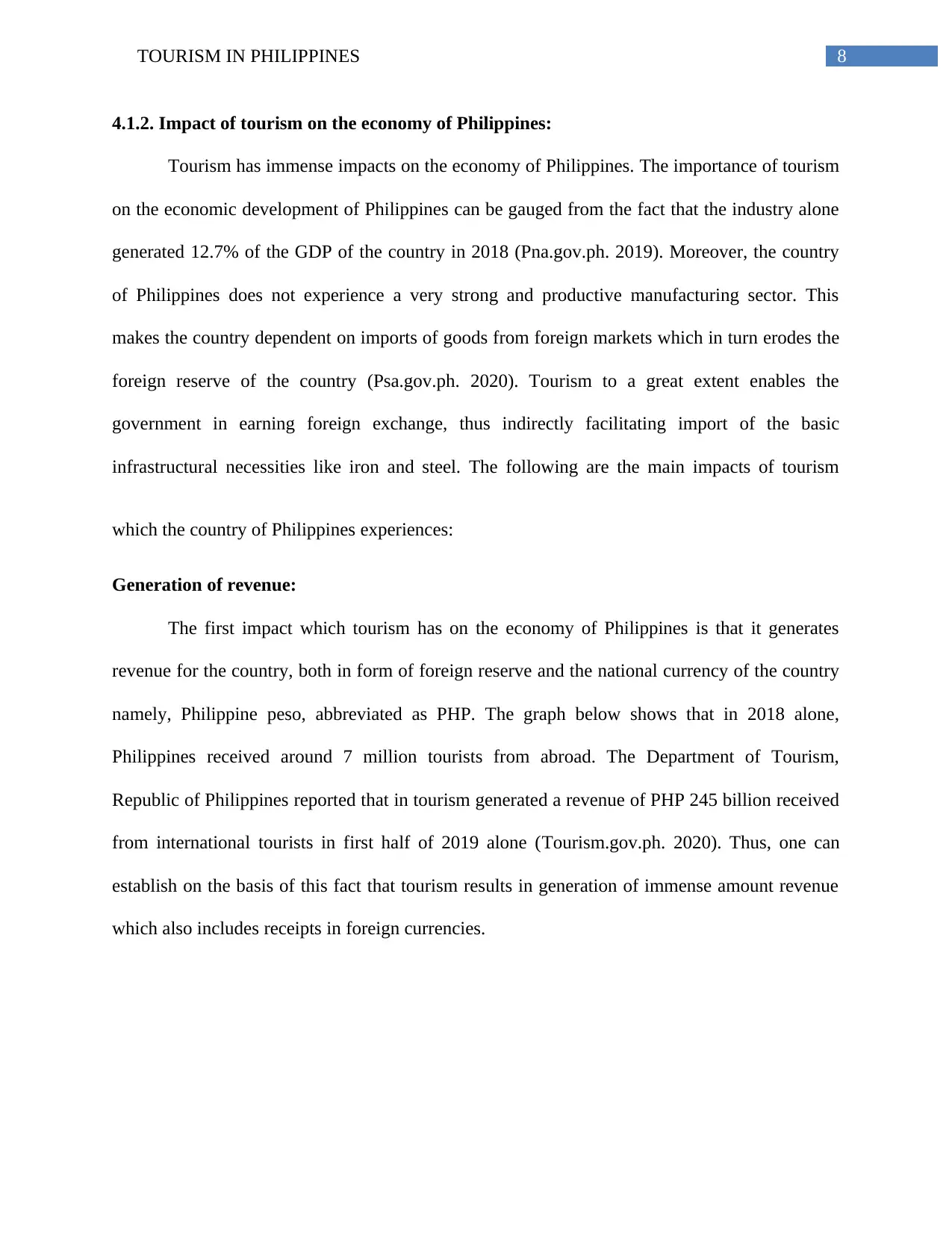
8TOURISM IN PHILIPPINES
4.1.2. Impact of tourism on the economy of Philippines:
Tourism has immense impacts on the economy of Philippines. The importance of tourism
on the economic development of Philippines can be gauged from the fact that the industry alone
generated 12.7% of the GDP of the country in 2018 (Pna.gov.ph. 2019). Moreover, the country
of Philippines does not experience a very strong and productive manufacturing sector. This
makes the country dependent on imports of goods from foreign markets which in turn erodes the
foreign reserve of the country (Psa.gov.ph. 2020). Tourism to a great extent enables the
government in earning foreign exchange, thus indirectly facilitating import of the basic
infrastructural necessities like iron and steel. The following are the main impacts of tourism
which the country of Philippines experiences:
Generation of revenue:
The first impact which tourism has on the economy of Philippines is that it generates
revenue for the country, both in form of foreign reserve and the national currency of the country
namely, Philippine peso, abbreviated as PHP. The graph below shows that in 2018 alone,
Philippines received around 7 million tourists from abroad. The Department of Tourism,
Republic of Philippines reported that in tourism generated a revenue of PHP 245 billion received
from international tourists in first half of 2019 alone (Tourism.gov.ph. 2020). Thus, one can
establish on the basis of this fact that tourism results in generation of immense amount revenue
which also includes receipts in foreign currencies.
4.1.2. Impact of tourism on the economy of Philippines:
Tourism has immense impacts on the economy of Philippines. The importance of tourism
on the economic development of Philippines can be gauged from the fact that the industry alone
generated 12.7% of the GDP of the country in 2018 (Pna.gov.ph. 2019). Moreover, the country
of Philippines does not experience a very strong and productive manufacturing sector. This
makes the country dependent on imports of goods from foreign markets which in turn erodes the
foreign reserve of the country (Psa.gov.ph. 2020). Tourism to a great extent enables the
government in earning foreign exchange, thus indirectly facilitating import of the basic
infrastructural necessities like iron and steel. The following are the main impacts of tourism
which the country of Philippines experiences:
Generation of revenue:
The first impact which tourism has on the economy of Philippines is that it generates
revenue for the country, both in form of foreign reserve and the national currency of the country
namely, Philippine peso, abbreviated as PHP. The graph below shows that in 2018 alone,
Philippines received around 7 million tourists from abroad. The Department of Tourism,
Republic of Philippines reported that in tourism generated a revenue of PHP 245 billion received
from international tourists in first half of 2019 alone (Tourism.gov.ph. 2020). Thus, one can
establish on the basis of this fact that tourism results in generation of immense amount revenue
which also includes receipts in foreign currencies.
⊘ This is a preview!⊘
Do you want full access?
Subscribe today to unlock all pages.

Trusted by 1+ million students worldwide
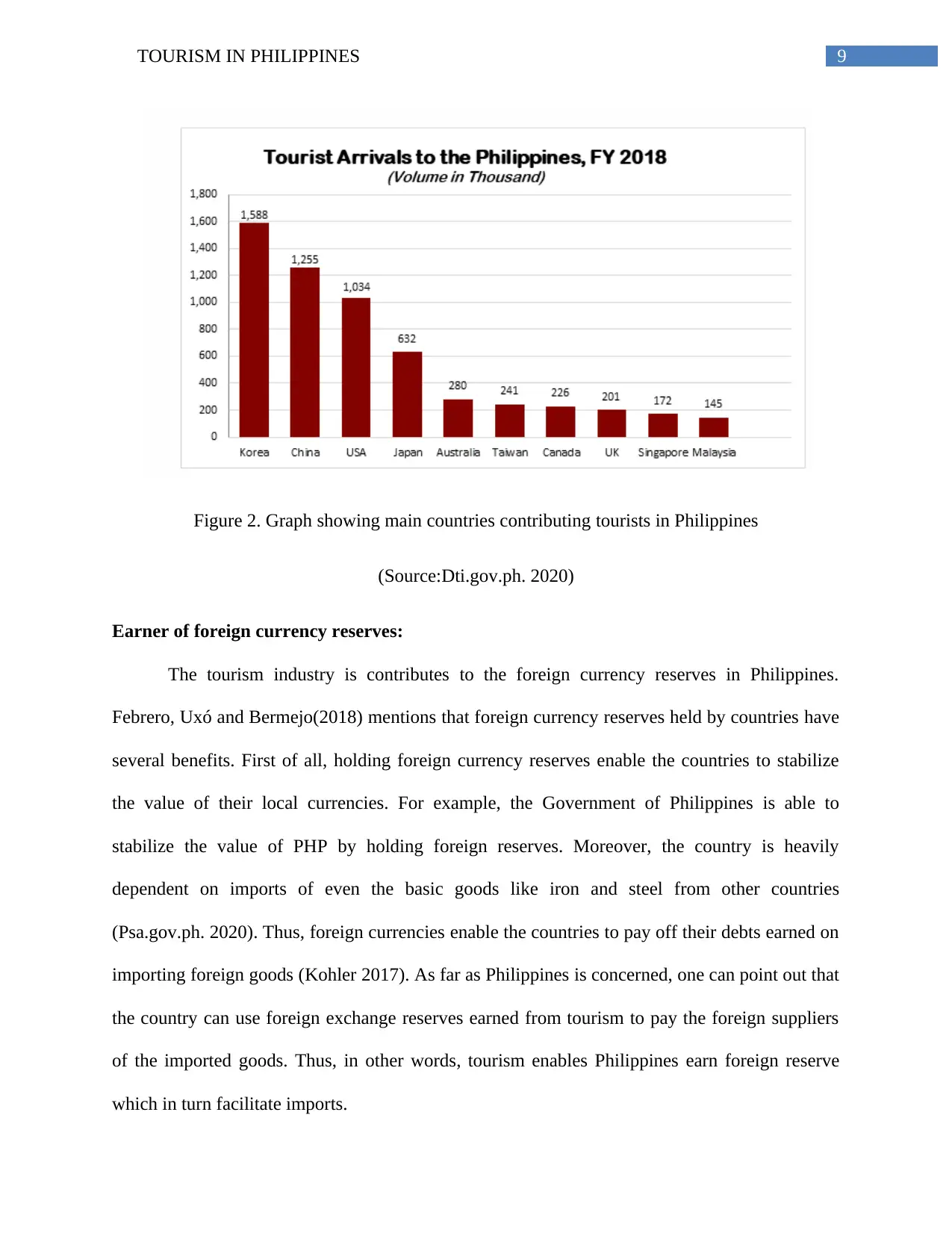
9TOURISM IN PHILIPPINES
Figure 2. Graph showing main countries contributing tourists in Philippines
(Source:Dti.gov.ph. 2020)
Earner of foreign currency reserves:
The tourism industry is contributes to the foreign currency reserves in Philippines.
Febrero, Uxó and Bermejo(2018) mentions that foreign currency reserves held by countries have
several benefits. First of all, holding foreign currency reserves enable the countries to stabilize
the value of their local currencies. For example, the Government of Philippines is able to
stabilize the value of PHP by holding foreign reserves. Moreover, the country is heavily
dependent on imports of even the basic goods like iron and steel from other countries
(Psa.gov.ph. 2020). Thus, foreign currencies enable the countries to pay off their debts earned on
importing foreign goods (Kohler 2017). As far as Philippines is concerned, one can point out that
the country can use foreign exchange reserves earned from tourism to pay the foreign suppliers
of the imported goods. Thus, in other words, tourism enables Philippines earn foreign reserve
which in turn facilitate imports.
Figure 2. Graph showing main countries contributing tourists in Philippines
(Source:Dti.gov.ph. 2020)
Earner of foreign currency reserves:
The tourism industry is contributes to the foreign currency reserves in Philippines.
Febrero, Uxó and Bermejo(2018) mentions that foreign currency reserves held by countries have
several benefits. First of all, holding foreign currency reserves enable the countries to stabilize
the value of their local currencies. For example, the Government of Philippines is able to
stabilize the value of PHP by holding foreign reserves. Moreover, the country is heavily
dependent on imports of even the basic goods like iron and steel from other countries
(Psa.gov.ph. 2020). Thus, foreign currencies enable the countries to pay off their debts earned on
importing foreign goods (Kohler 2017). As far as Philippines is concerned, one can point out that
the country can use foreign exchange reserves earned from tourism to pay the foreign suppliers
of the imported goods. Thus, in other words, tourism enables Philippines earn foreign reserve
which in turn facilitate imports.
Paraphrase This Document
Need a fresh take? Get an instant paraphrase of this document with our AI Paraphraser
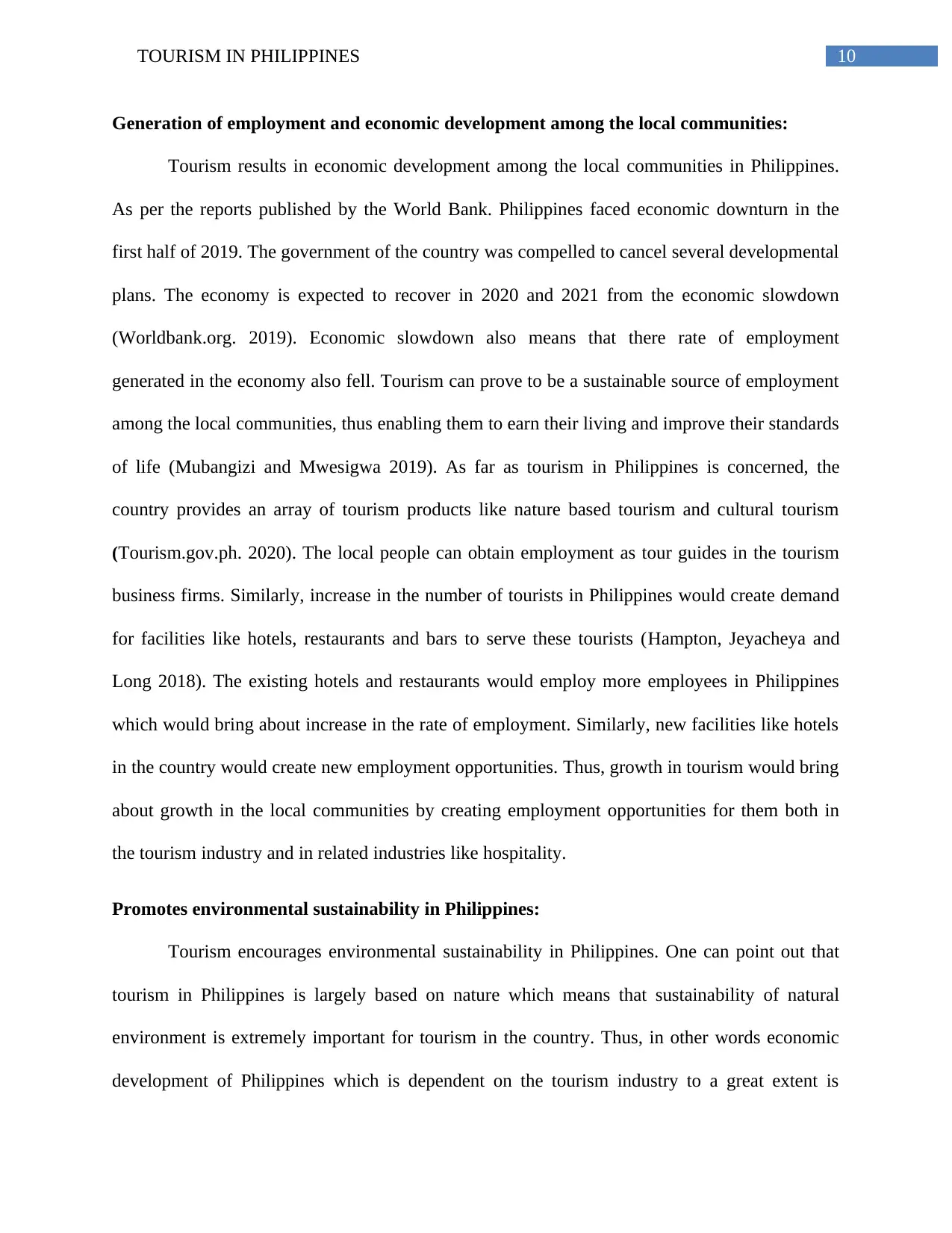
10TOURISM IN PHILIPPINES
Generation of employment and economic development among the local communities:
Tourism results in economic development among the local communities in Philippines.
As per the reports published by the World Bank. Philippines faced economic downturn in the
first half of 2019. The government of the country was compelled to cancel several developmental
plans. The economy is expected to recover in 2020 and 2021 from the economic slowdown
(Worldbank.org. 2019). Economic slowdown also means that there rate of employment
generated in the economy also fell. Tourism can prove to be a sustainable source of employment
among the local communities, thus enabling them to earn their living and improve their standards
of life (Mubangizi and Mwesigwa 2019). As far as tourism in Philippines is concerned, the
country provides an array of tourism products like nature based tourism and cultural tourism
(Tourism.gov.ph. 2020). The local people can obtain employment as tour guides in the tourism
business firms. Similarly, increase in the number of tourists in Philippines would create demand
for facilities like hotels, restaurants and bars to serve these tourists (Hampton, Jeyacheya and
Long 2018). The existing hotels and restaurants would employ more employees in Philippines
which would bring about increase in the rate of employment. Similarly, new facilities like hotels
in the country would create new employment opportunities. Thus, growth in tourism would bring
about growth in the local communities by creating employment opportunities for them both in
the tourism industry and in related industries like hospitality.
Promotes environmental sustainability in Philippines:
Tourism encourages environmental sustainability in Philippines. One can point out that
tourism in Philippines is largely based on nature which means that sustainability of natural
environment is extremely important for tourism in the country. Thus, in other words economic
development of Philippines which is dependent on the tourism industry to a great extent is
Generation of employment and economic development among the local communities:
Tourism results in economic development among the local communities in Philippines.
As per the reports published by the World Bank. Philippines faced economic downturn in the
first half of 2019. The government of the country was compelled to cancel several developmental
plans. The economy is expected to recover in 2020 and 2021 from the economic slowdown
(Worldbank.org. 2019). Economic slowdown also means that there rate of employment
generated in the economy also fell. Tourism can prove to be a sustainable source of employment
among the local communities, thus enabling them to earn their living and improve their standards
of life (Mubangizi and Mwesigwa 2019). As far as tourism in Philippines is concerned, the
country provides an array of tourism products like nature based tourism and cultural tourism
(Tourism.gov.ph. 2020). The local people can obtain employment as tour guides in the tourism
business firms. Similarly, increase in the number of tourists in Philippines would create demand
for facilities like hotels, restaurants and bars to serve these tourists (Hampton, Jeyacheya and
Long 2018). The existing hotels and restaurants would employ more employees in Philippines
which would bring about increase in the rate of employment. Similarly, new facilities like hotels
in the country would create new employment opportunities. Thus, growth in tourism would bring
about growth in the local communities by creating employment opportunities for them both in
the tourism industry and in related industries like hospitality.
Promotes environmental sustainability in Philippines:
Tourism encourages environmental sustainability in Philippines. One can point out that
tourism in Philippines is largely based on nature which means that sustainability of natural
environment is extremely important for tourism in the country. Thus, in other words economic
development of Philippines which is dependent on the tourism industry to a great extent is
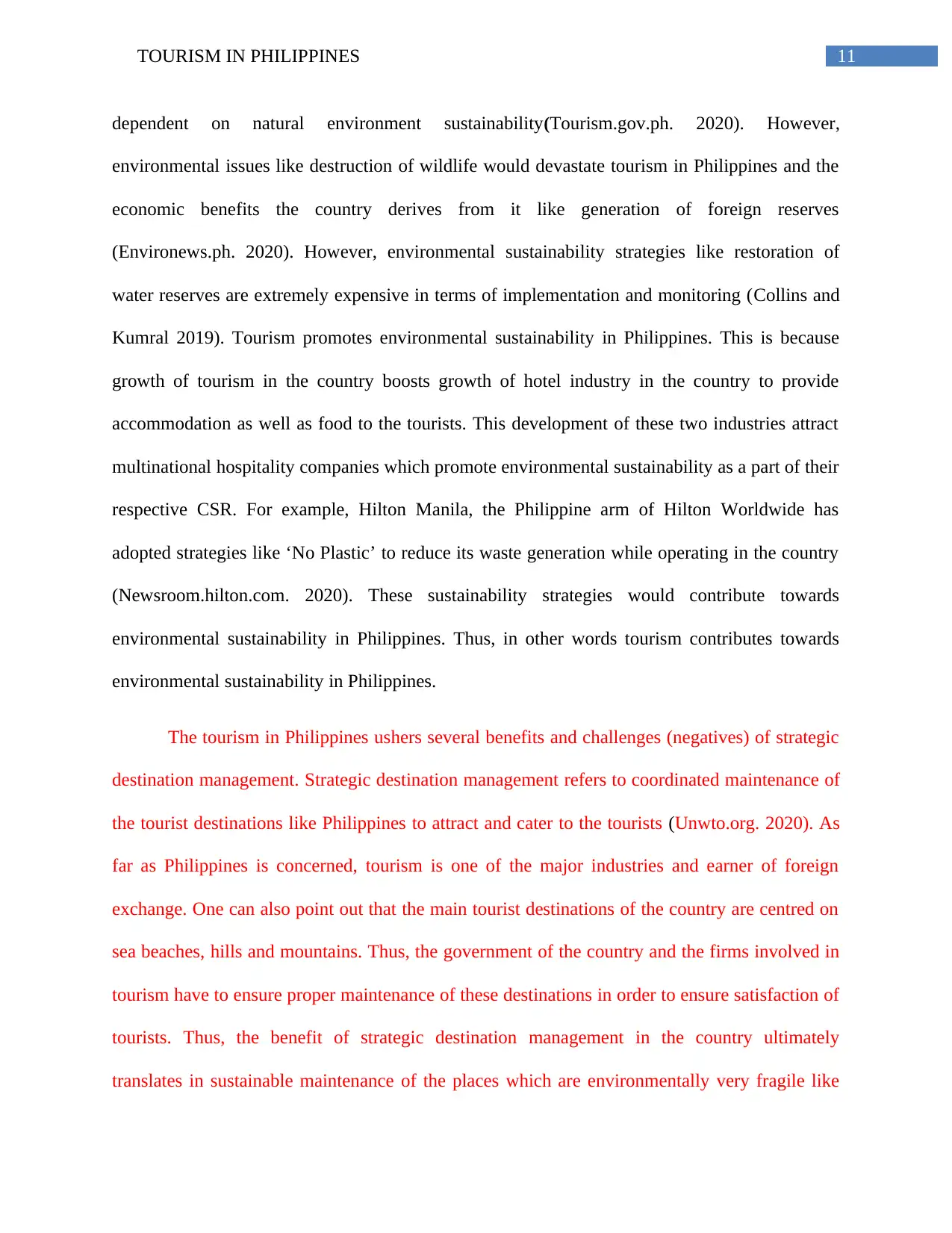
11TOURISM IN PHILIPPINES
dependent on natural environment sustainability(Tourism.gov.ph. 2020). However,
environmental issues like destruction of wildlife would devastate tourism in Philippines and the
economic benefits the country derives from it like generation of foreign reserves
(Environews.ph. 2020). However, environmental sustainability strategies like restoration of
water reserves are extremely expensive in terms of implementation and monitoring (Collins and
Kumral 2019). Tourism promotes environmental sustainability in Philippines. This is because
growth of tourism in the country boosts growth of hotel industry in the country to provide
accommodation as well as food to the tourists. This development of these two industries attract
multinational hospitality companies which promote environmental sustainability as a part of their
respective CSR. For example, Hilton Manila, the Philippine arm of Hilton Worldwide has
adopted strategies like ‘No Plastic’ to reduce its waste generation while operating in the country
(Newsroom.hilton.com. 2020). These sustainability strategies would contribute towards
environmental sustainability in Philippines. Thus, in other words tourism contributes towards
environmental sustainability in Philippines.
The tourism in Philippines ushers several benefits and challenges (negatives) of strategic
destination management. Strategic destination management refers to coordinated maintenance of
the tourist destinations like Philippines to attract and cater to the tourists (Unwto.org. 2020). As
far as Philippines is concerned, tourism is one of the major industries and earner of foreign
exchange. One can also point out that the main tourist destinations of the country are centred on
sea beaches, hills and mountains. Thus, the government of the country and the firms involved in
tourism have to ensure proper maintenance of these destinations in order to ensure satisfaction of
tourists. Thus, the benefit of strategic destination management in the country ultimately
translates in sustainable maintenance of the places which are environmentally very fragile like
dependent on natural environment sustainability(Tourism.gov.ph. 2020). However,
environmental issues like destruction of wildlife would devastate tourism in Philippines and the
economic benefits the country derives from it like generation of foreign reserves
(Environews.ph. 2020). However, environmental sustainability strategies like restoration of
water reserves are extremely expensive in terms of implementation and monitoring (Collins and
Kumral 2019). Tourism promotes environmental sustainability in Philippines. This is because
growth of tourism in the country boosts growth of hotel industry in the country to provide
accommodation as well as food to the tourists. This development of these two industries attract
multinational hospitality companies which promote environmental sustainability as a part of their
respective CSR. For example, Hilton Manila, the Philippine arm of Hilton Worldwide has
adopted strategies like ‘No Plastic’ to reduce its waste generation while operating in the country
(Newsroom.hilton.com. 2020). These sustainability strategies would contribute towards
environmental sustainability in Philippines. Thus, in other words tourism contributes towards
environmental sustainability in Philippines.
The tourism in Philippines ushers several benefits and challenges (negatives) of strategic
destination management. Strategic destination management refers to coordinated maintenance of
the tourist destinations like Philippines to attract and cater to the tourists (Unwto.org. 2020). As
far as Philippines is concerned, tourism is one of the major industries and earner of foreign
exchange. One can also point out that the main tourist destinations of the country are centred on
sea beaches, hills and mountains. Thus, the government of the country and the firms involved in
tourism have to ensure proper maintenance of these destinations in order to ensure satisfaction of
tourists. Thus, the benefit of strategic destination management in the country ultimately
translates in sustainable maintenance of the places which are environmentally very fragile like
⊘ This is a preview!⊘
Do you want full access?
Subscribe today to unlock all pages.

Trusted by 1+ million students worldwide
1 out of 31
Related Documents
Your All-in-One AI-Powered Toolkit for Academic Success.
+13062052269
info@desklib.com
Available 24*7 on WhatsApp / Email
![[object Object]](/_next/static/media/star-bottom.7253800d.svg)
Unlock your academic potential
Copyright © 2020–2025 A2Z Services. All Rights Reserved. Developed and managed by ZUCOL.




